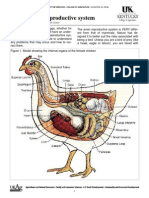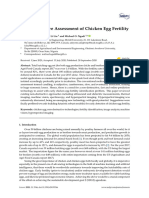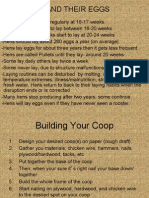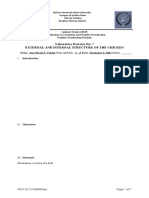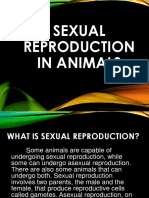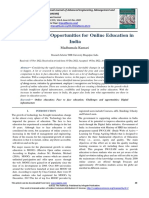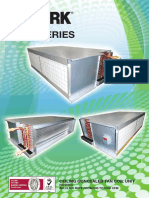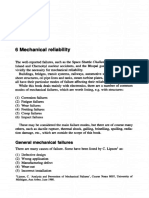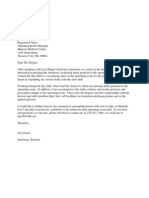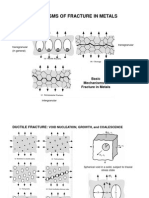10/17/23
POULTRY
SCIENCE:
Reproductive Physiology
& Egg Development
Unit 6
Poultry Science:
Reproductive Physiology &
Egg Development
Unit 6: Segment 1
Male Reproductive System
1
� 10/17/23
Avian Male
Reproductive System
– Paired testes
– Poorly developed
epididymis
– Vas deferens
– Rudimentary phallus
Hormone Regulation
1. Photoperiodic Control
– Perceives changes in day length
– Stimulates HPG axis
2. Gonadal Changes
– Growth and regression
3. Secondary Sex Characteristics
– Comb and wattle growth and coloration change
4. Feather Changes
– Grow long hackles, sickle, and saddle feathers
2
� 10/17/23
Testes
– Testes (pair) are located on the back wall
just above the kidney within the
abdomen.
– Constitutes 1% of body mass in most
birds.
– 2-3% in Quail
– Left testis is usually larger than the right,
reason being is unknown but testicular
size is related to male competition.
Structure of a Testis
– Birds have a poorly developed epididymis
– In mammals, the epididymis acts as a sperm
storage area (up to 60 days), absorbs fluid, sperm
mature (swim)
– Site of sperm production
– Made up of many clusters of tubes or
seminiferous tubules
3
� 10/17/23
Testis: Seminiferous Tubule
Leydig Cells
• Responsible for testicular androgen production
Hypothalamus -
GnRH (Gonadotrophin
Releasing Hormone)
- Anterior Pituitary -
FSH LH
Sertoli Leydig
Inhibin Cells Cells
Regulates Sperm
Testosterone
production
8
4
� 10/17/23
Spermatogenesis
Spermatogenesis – maturation to functional sperm
– Spermatozoa produced in seminiferous tubules
– Effected by temperature
– Bird sperm is more tolerant of high temperatures
– Time to maturation:
– 13 days in birds
– 34-75 days in mammals
– Little sperm storage in birds and seasonal breeding
Spermiogenesis
Morphological changes
– Spermatid to
spermatozoa
– Formation of the
acrosome cap and tail
10
5
� 10/17/23
Transport of Semen
Vas Deferens
– Wavy ducts that run along urinary duct
– Transports sperm to cloaca for ejaculation
– Duration of 20-30 days non-sexually active
– Only 1-3 days in sexually active males
– Enlarged near the cloaca
– Stores a small amount of semen
– Mammals: sperm storage in testis and epididymis for duration of 60 days
11
Avian Phallus
Rudimentary Penis
– Absence of a true intromittent penis in the chicken,
turkey, and quail (no penis)
– When mating becomes enlarged with lymph fluid being
added to sperm (semen)
– Chickens, turkeys, pheasant, and quail have a V-shaped
phallus
– Waterfowl and ratites have a more well-developed
corkscrew-shaped phallus
12
6
� 10/17/23
Mating
Since the rooster has a
rudimentary penis, he must
have close cloacal contact with
the hen for semen to be
passed to her (insemination).
13
Summary of Differences:
Birds Mammals
– No accessory glands – Accessory glands
– Highly concentrated semen – Low concentrated semen
– Small ejaculate volume – Large ejaculate volume
– Internal testis – External testis
– Large testes to weight ratio – Low testes to weight ration
– Little semen storage – Semen stored in testis and
– No capacitation epididymis
– Capacitation required
14
7
� 10/17/23
Poultry Science:
Reproductive Physiology &
Egg Development
Unit 6: Segment 2
Female Reproductive System
15
Avian Female
Reproductive System
– Left Ovary
– Left Oviduct
OVIDUCT – Single Egg (Ovum) is produced every
day
– Follicle does not form a corpus luteum
after ovulation
– Sperm storage tubules
16
8
� 10/17/23
Oviduct of a
Laying Hen
Infundibulum – site of fertilization
Magnum – secretion of egg albumen
Isthmus – secretion of inner and outer
shell membranes
Shell Gland – shell formation
Utero-Vaginal Junction – location of
sperm host glands for sperm storage
Vagina – passageway to cloaca and site
of sperm selection
17
Ovarian Development
– First 14-15 weeks of life there is not much happening in the female
reproductive system.
– Around 15 weeks, the hypothalamic/pituitary axis matures, allowing
for:
– Photostimulation (long day length) is the message to start egg
production
– Secondary sexual characteristics
– Ovary and oviduct growth and development
– Female must be at an appropriate body weight to respond to
Photostimulation (proper nutrient intake)
18
9
� 10/17/23
Hormonal Control
Photoperiodic Control
– Perceives changes in day length
– Stimulates HPG axis (“Photostimulation”)
Gonadal Changes
– Growth and regression
– Ovary
– Follicle Stimulating Hormone (FSH) – gets the follicles going by stimulating Theca cells of the small
follicles to produce estrogen
– Luteinizing Hormone (LH) – stimulates granulosa cells to produce progesterone
– Oviduct
Secondary Sexual Characteristics
– Comb color and size
19
Follicular
Development
– Begins with small, white follicle
– These grow to become small,
yellow follicles
– Next, the SYF are selected to
become large yellow follicles for
hierarchical follicles
– F1 will ovulate around 24 hours, and F2
in 48 hours
20
10
� 10/17/23
Follicular
Development
– Ovarian follicles develop
and mature -> graduated
sizes, with various sizes
having different functions
– Theca cells of small, white,
immature follicles produce
estrogen and androgens
– Granulosa cells produce
progesterone
21
Oviduct Function
– Capture ovulated ovum
– Site of fertilization
– Transport and expulsion of ovum
– Sperm storage
– Site of early embryo development
– Secretion of albumen, fluids, shell membranes, shell, and shell pigments
22
11
� 10/17/23
Internal Layer
The infundibulum doesn’t always pick up
the follicle…
– When this happens, the follicle drops into
the abdomen and the body tries to
reabsorb it, but this can lead to abdominal
infections.
23
Requirements for Successful
Natural Fertilization
It is suggested that only one of the following conditions be
met to ensure successful fertilization:
1. Long fertilizable life span for ova and/or sperm
2. Accurate synchronization between copulation and ovulation
3. Copulations must occur frequently to ensure viable sperm at
the time of ovulation
24
12
� 10/17/23
Requirements for Successful
Fertilization
– Synchronization between ovulation and oviposition -> ovulation of
the next follicle occurs approximately 30 minutes (15-75 min.
range) after oviposition.
– Sperm released from U.V.J. would have 20-30 minutes to traverse
an empty oviduct and fertilize the next ovum to be ovulated.
25
Requirements for Successful
Fertilization: Domestic Chickens
Long fertilizable life span of ovum: 15-30 Minutes
Long retention of fertilizing capacity by sperm: 10-14 Days
Synchronization between copulation and ovulation: None. No typical Estrus Cycle as in
humans.
Ovulation induced by copulation: None.
Capacitation: None. Mammal sperm must incubate 3 hours before it an fertilize the
egg.
26
13
� 10/17/23
Poultry Science:
Reproductive Physiology &
Egg Development
Unit 6: Segment 3
Egg Development
27
Egg Formation
28
14
� 10/17/23
Egg
Formation
29
Egg Structure
– Shell
– Shell Membranes
– Thin Albumen
– Thick Albumen
– Yolk
– Germinal Disc
– Chalaza
30
15
� 10/17/23
Egg Laying
– Hens lay clutches (number of eggs laid in a row) of eggs
followed by a pause or “skip day”, and may be one of two
situations:
– Once a pattern has been established, birds will stick to it,
especially chickens.
– With chickens, if you take their eggs away every day, they
will have a continuation of lay period with an occasional
skip day.
– If you do not remove the eggs daily, the hen will become
broody and discontinue laying.
31
Egg-cellent Facts
– An egg contains approximately 10,000 pores that allow for
the diffusion of gases through the pores.
– In order to minimize water loss from eggs during storage
for both table and hatching eggs, it is important to store
them at 75-85% humidity.
– In Grade-AA eggs, the air cell may not exceed 1/8” in depth
and is about the size of a dime.
– Grade-A eggs may have air cells over 3/16” in depth, but
there is no limit on air cell size for Grade-B eggs.
32
16
� 10/17/23
Poultry Science
Curriculum References
– Jessica Fife, UGA Dept. of Poultry – University of Arkansas Bumpers College – Tom Tabler, Mississippi State University
Science Outreach Coordinator, UGA of Poultry Science – Poultry Science Department of Poultry Science
Dept. of Agricultural Leadership, Dual Curriculum Course Extension Professor
Education, & Communication MAEE
Candidate – Julia Gaskin, UGA Dept. of Crop and Soil – Jacquie Jacob, University of Kentucky
Sciences Sr. Public Service Associate
– Barry Croom, UGA Dept. of Agricultural – Jeanna Wilson, UGA Dept. of Poultry
Leadership, Education, & – Glendon Harris, UGA Dept. of Crop and Science Professor
Communication Professor Soil Sciences Professor & Extension
Agronomist – Kelly Sweeney, UGA Dept. of Poultry
– Ashley Yopp, UGA Dept. of Agricultural Science Ph.D Candidate
Leadership, Education, & – Brian Kiepper, UGA Dept. of Poultry
Science Associate Professor – Merck Veterinary Manual
Communication Assistant Professor
– Claudia Dunkley, UGA Dept. of Poultry – University of Maryland Extension
– Georgia Agriculture Education
Science Public Service Associate – Poultry Hub
– Andrew Benson, UGA Dept. of Poultry
Science Assistant Professor – Casey Ritz, UGA Dept. of Poultry – Brian Fairchild, University of Georgia
Science Professor Department of Poultry Science
– Brian Jordan, UGA Dept. of Poultry Professor
Science Assistant Professor, UGA – USPOULTRY & USPOULTRY Poultry
College of Veterinary Medicine Science Curriculum – Centers for Disease Control
Assistant Professor – National FFA Organization
33
17




